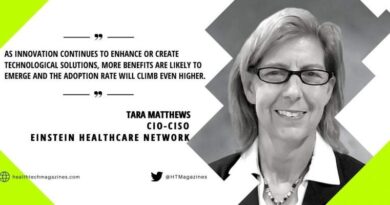Remote Patient Monitoring in the age of COVID-19
By Alka Kohli, MD, MBA, EVP & Chief Population Health and Clinical Officer, Inspira Health
While the health care industry has always championed and driven innovation, the COVID-19 pandemic has advanced and accelerated the pace at which many technologies have evolved – even those that were already being used by health care professionals and patients before the pandemic struck.
Such is true for remote patient monitoring, an at-home solution that continues to advance the standard of care for many medical conditions.
Remote patient monitoring can be defined simply as the use of technology, such as a fitness tracker, scale, glucometer, or blood pressure cuff, to assess patients outside of a clinical setting regularly. The technology not only records biometric data but also transmits it to a care team in real-time to ensure immediate intervention if and when necessary.
Patients can manage this entire process independently without the direct involvement of a physician, but the most comprehensive method is done with an integrated team of clinicians.
The value of remote patient monitoring
This type of patient assessment provides immense value to both patients and health care providers.
First, the remote monitoring tools empower patients to take control of their health and in many cases, better understand how their lifestyle choices impact their condition. In fact, most chronic diseases can be prevented, resolved, or improved with adjustments to patient behaviors. For those already living with chronic diseases, such as asthma, COPD, or diabetes, around-the-clock, remote monitoring helps to highlight these behaviors (daily health checks, exercise, diet, etc.) to avoid exacerbating the illness. This also prevents the “rising risk” population – those who are currently toward the center of the risk spectrum, but could increase without careful attention – from becoming “high-risk” patients.
Because patients know their data is being transmitted to and reviewed by their care team, remote monitoring also improves patient accountability. A diabetic patient, for example, might be less likely to neglect their health management plan if they know their doctor will be alerted of a spike in blood sugar.
Remote monitoring programs also expand access to quality health care for patients with socio-economic barriers or those who live in more rural locations. With these tools, a patient without access to transportation can still receive quality care and attention comparable to that of a patient who can travel to their physician regularly.
As COVID-19 became more prevalent in Southern New Jersey, the network, like many others across the country, developed a surge plan to respond to the concern of reaching capacity in our hospitals.
Remote monitoring in a pandemic
Last year, when we first began using these tools, they were available for employees and their spouses insured under an Inspira Health medical plan. After its initial success, the program was then expanded to any patients of our primary care practices who were found appropriate to participate through claims data or a physician’s referral. This was the foundation for what we now call Inspira Health+ Technology-Assisted Care Management, an innovative program that provides around-the-clock monitoring and personalized health actions to help patients monitor their health condition from home.
But the pandemic introduced an additional use case for Health+. As COVID-19 became more prevalent in Southern New Jersey, the network, like many others across the country, developed a surge plan to respond to the concern of reaching capacity in our hospitals. As part of this plan, we needed to address how we could discharge COVID-19 patients as quickly and safely as possible to make room for new patients. This necessitated expanding Health+, which, entering its second year, already included access to a wireless pulse oximeter that automatically sends data in real-time to a care team through a small digital base station provided to each patient in the program.
In response to the pandemic, we updated the Health+ suite of tools with a thermometer to better monitor for COVID-19 symptoms, as well as implemented a two-part post-discharge program for patients. Through this program, the patient first received an at-home virtual visit with a provider the day after discharge. Then the patient began to use a remote monitoring kit comprising a thermometer and pulse oximeter so the care team could closely monitor their temperature and oxygen levels throughout their recovery.
The use of remote patient monitoring in this capacity led to two significant outcomes. First, care teams quickly identified a very small number of patients who were decompensating at home and advised them to seek acute care. Second, the length of stay at the hospital was significantly reduced. Most patients were able to be successfully weaned off oxygen in their homes while keeping in close touch with their care team and physician. One of our pulmonologists shared a story of a patient whose hospital stay was likely shortened by 50 percent thanks to the Health+ program. The patient was monitored closely at home as she continued to use supplemental oxygen for two months.
Remote monitoring in a post-pandemic world
Given the success of Health+ and remote monitoring programs at large, there are several use cases for these tools in a post-pandemic environment. With the rise in virtual visits, remote monitoring can become an asset to monitoring biometrics used in guiding care – not only for primary care providers but for specialists such as endocrinologists, cardiologists, and pulmonologists.
Additionally, remote monitoring programs can expand beyond hospitals and primary care to skilled nursing facilities, with the goal of reducing hospital readmissions. Many patients are transferred from a hospital to a skilled nursing facility, and having this program initiated by the facility can ensure the patients’ care continues when they return home.
Lastly, remote patient monitoring could bring us closer to a hospital-at-home model. Widely adopted in countries like England, Canada, and Israel, this model of care has been shown to improve patients’ outcomes and reduce health care costs.
Necessity is the mother of invention, and while COVID-19 has been the greatest challenge of our lifetime, it has also driven technological innovation in remarkable ways. With remote patient monitoring solutions, our network and many others will continue to provide high-quality health care to those who need it most, well after the pandemic ends.



